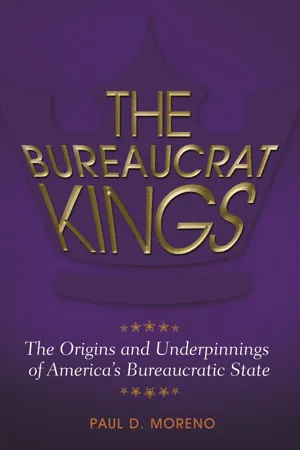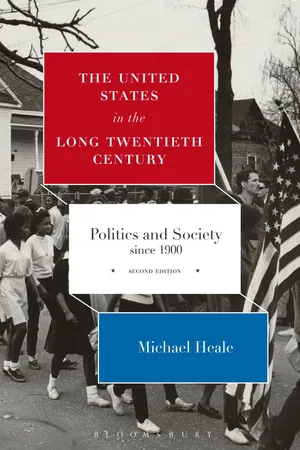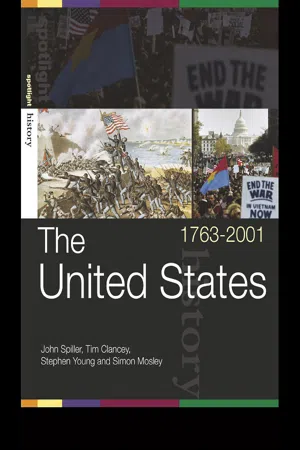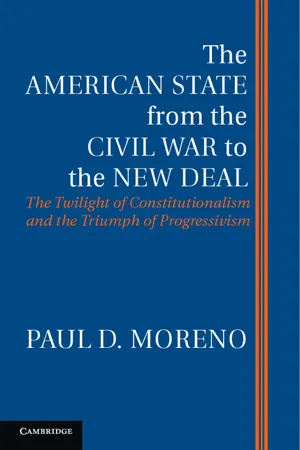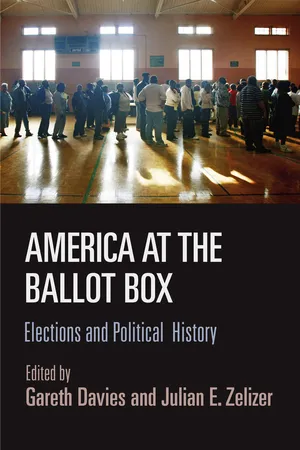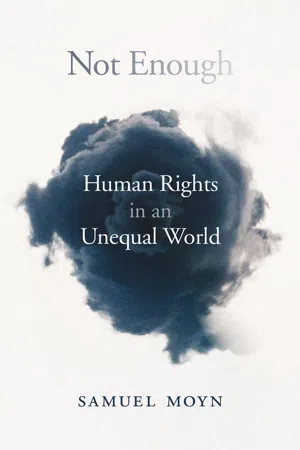History
Second New Deal
The Second New Deal was a series of economic and social programs implemented by President Franklin D. Roosevelt in the 1930s, following the First New Deal. It aimed to address the ongoing effects of the Great Depression by introducing additional relief and reform measures, including the Social Security Act, the Works Progress Administration, and the National Labor Relations Act.
Written by Perlego with AI-assistance
Related key terms
1 of 5
10 Key excerpts on "Second New Deal"
- eBook - PDF
The Bureaucrat Kings
The Origins and Underpinnings of America's Bureaucratic State
- Paul D. Moreno(Author)
- 2016(Publication Date)
- Praeger(Publisher)
CHAPTER 5 The Second Wave: The New Deal Era, 1930–1945 T he New Deal marked the second wave of the development of an American bureaucratic state. It built on the progressive intellectual campaign to reconceive the purpose of government, providing a fuller articulation of the state as an entitlement-provider rather than a rights- protector. It established a host of new regulatory agencies (the “alphabet soup” of abbreviations and acronyms, from the AAA through the NIRA to the WPA), most of which empowered bureaucrats to manage and re- distribute economic resources, with special attention given to farmers and workers. In 1937, shortly after his landslide re-election, Franklin Delano Roosevelt (known as “FDR”) and his New Deal ran aground due to his crackpot scheme to “pack” the Supreme Court, the labor union mayhem, and a depression within the Depression. This political setback frustrated Roosevelt’s efforts to bring the sprawling bureaucracies under centralized White House control. At the same time, his conservative opponents were unable to roll back any of the New Deal, nor to subject it to more tradi- tional rule-of-law controls. American involvement in World War Two opened a new avenue for New Dealers to extend the bureaucratic state. The president, his advisers, and academic enthusiasts envisioned comple- tion of the stalled national welfare state when the war was won. The most that they were able to do, however, was to fend off a conservative reaction similar to that of the 1920s and lock in their earlier achievements. The New Deal completed the movement begun by the progressives to redefine the purpose of government. The protracted economic depres- sion that began in 1929 gave the Roosevelt administration the opportu- nity to extend much of the bureaucratic system that had been temporarily or incompletely established in the previous three decades, and the Second 84 The Bureaucrat Kings World War further entrenched it. - eBook - ePub
The Bureaucrat Kings
The Origins and Underpinnings of America's Bureaucratic State
- Paul D. Moreno(Author)
- 2016(Publication Date)
- Praeger(Publisher)
CHAPTER 5 The Second Wave: The New Deal Era, 1930–1945T he New Deal marked the second wave of the development of an American bureaucratic state. It built on the progressive intellectual campaign to reconceive the purpose of government, providing a fuller articulation of the state as an entitlement-provider rather than a rights-protector. It established a host of new regulatory agencies (the “alphabet soup” of abbreviations and acronyms, from the AAA through the NIRA to the WPA), most of which empowered bureaucrats to manage and redistribute economic resources, with special attention given to farmers and workers. In 1937, shortly after his landslide re-election, Franklin Delano Roosevelt (known as “FDR”) and his New Deal ran aground due to his crackpot scheme to “pack” the Supreme Court, the labor union mayhem, and a depression within the Depression. This political setback frustrated Roosevelt’s efforts to bring the sprawling bureaucracies under centralized White House control. At the same time, his conservative opponents were unable to roll back any of the New Deal, nor to subject it to more traditional rule-of-law controls. American involvement in World War Two opened a new avenue for New Dealers to extend the bureaucratic state. The president, his advisers, and academic enthusiasts envisioned completion of the stalled national welfare state when the war was won. The most that they were able to do, however, was to fend off a conservative reaction similar to that of the 1920s and lock in their earlier achievements.The New Deal completed the movement begun by the progressives to redefine the purpose of government. The protracted economic depression that began in 1929 gave the Roosevelt administration the opportunity to extend much of the bureaucratic system that had been temporarily or incompletely established in the previous three decades, and the Second World War further entrenched it. The New Dealers proceeded on the theory that the Founders’ constitution had been “outgrown,” and that America needed a new kind of government—not one that merely protected individual natural rights, but one that defined and provided - eBook - PDF
The United States in the Long Twentieth Century
Politics and Society since 1900
- Michael Heale(Author)
- 2014(Publication Date)
- Bloomsbury Academic(Publisher)
102 8 Franklin D. Roosevelt’s New Deal, 1933–45 The New Deal Order, as we have defined it, may have lasted for over a third of a century, but the New Deal itself comprised the reforming measures of Franklin Roosevelt’s remarkable administration. When FDR was sworn in as president in 1933 great swathes of the economy lay in ruins and over 12 million dispirited Americans were searching for work. In that year per capita Gross National Product sank to its lowest level in thirty years, to just $590 (in 1929 prices). When death eventually released Roosevelt from his duties in 1945, agriculture and industry were booming, unemployment was negligible, and per capita GNP was a massive $1,293. Much of this transformation was owed to the Second World War, but even before the war the New Deal was reshaping both the American landscape and the nature of government. New highways, dams, buildings, forests and parks stood as monuments to the government’s determination to resist fate. Industrial workers, the unemployed, children, bankers, farmers and devastated regions had been afforded some governmental protection against the vagaries of the market. ‘Our government is not the master but the creature of the people,’ Franklin Roosevelt had insisted in 1931. ‘The duty of the state towards the citizens is the duty of the servant to its master.’ He was no intellectual and he never offered a sophisticated account of the role of the state in modern society, but Roosevelt did believe in the potential of government for improving the lot of humankind. That faith was central to the New Deal. * * * There was no absolute break between Progressive America and New Deal America, and the continuity was personified by Roosevelt himself. He was a quintessential WASP, a member of a New York gentry family and a distant cousin of Theodore Roosevelt. He married another distant cousin Eleanor Roosevelt (seemingly a family tradition since his parents had done the same). - eBook - ePub
- Tim Clancey, Simon Mosley, John Spiller, Stephen Young(Authors)
- 2004(Publication Date)
- Routledge(Publisher)
it had. Outline criticisms from both left- and right-wing groups and individuals.Conclusion: The people, and consequently their representatives in Congress, were largely supportive of the measures taken to alleviate the effects of the Depression. A consistent source of opposition came from conservative groups, business leaders and Republicans. Identify the common ground between their opinions and use this to show why the New Deal stands as one the most remarkable periods of legislation in the US.The results of the New Deal
9 (a) Why was there a Second New Deal in 1935? (7)(b) Did Roosevelt change direction in 1935? (18)(Edexcel)(a) The major legislating phase of the New Deal can be said to have lasted around 1,000 days, although some commentators have proposed a six-year period for the New Deal (Brogan) and a ‘Third New Deal’ in 1938 has been suggested (Clements). Of these 1,000 days, two periods of intense activity stand out. The initial ‘Hundred Days’ following Roosevelt’s inauguration in March 1933 saw the passage of 14 significant pieces of legislation. The pace slackened after 16 June 1933, but important Acts concerning financial reforms were passed in 1934. This period is usually spoken of as the First New Deal.A ‘Second Hundred Days’ of frantic law-making arrived in spring 1935. At least seven major Acts were passed during this period, usually termed the Second New Deal. Whether or not it represented a change of direction for Roosevelt’s administration is open for debate. The very notion of a Second New Deal has been played down by some who highlight the continuity with past measures and point out that several of the reforms of 1935 had long been in preparation (Jones). But in terms of the number of important Acts passed, it is appropriate to claim there was a renewed momentum to legislate in early 1935.There were numerous reasons behind this. The continuing economic crisis was a significant factor in prompting further action from the White House. Although unemployment had been reduced a little, the hoped-for economic recovery had failed to materialise. Work relief measures were collated and extended under the Works Progress Administration as it became clear that unemployment was going to be a long-term problem. The business community had removed their support for the New Deal after the first year and the President resented their perceived ingratitude towards his administration. Roosevelt was facing a drawn-out struggle against the Depression as well as being the object of criticism from both left and right. In this light it is hardly surprising that he kept Congress in session throughout the summer and demanded they accept major pieces of legislation. - eBook - PDF
The American State from the Civil War to the New Deal
The Twilight of Constitutionalism and the Triumph of Progressivism
- Paul D. Moreno(Author)
- 2013(Publication Date)
- Cambridge University Press(Publisher)
The unusually large midterm election gains for the president’s party did not indicate whether the electorate endorsed the president or his policies. 3 Roosevelt pressed the new Congress to enact legislation that historians have called the “Second New Deal” or the “second hundred days.” 4 “We have under- taken a new order of things,” Roosevelt told the new Congress in January 1935, “yet we progress to it under the framework and in the spirit and intent of the American Constitution.” He called for further steps toward “social justice,” which governments around the world had begun to undertake. 5 He advocated old-age insurance, unemployment insurance and provision for dependent chil- dren. Congress enacted the landmark Social Security Act in June 1935. It provided for unemployment insurance through the familiar grants-in-aid sys- tem, but included more federal control. States paid taxes into the federal treas- ury, to establish a fund upon which they could draw for unemployment compensation systems approved by a federal Social Security Board. It also established a completely national program of old-age insurance. 6 Advocates of a fully national welfare state have long lamented the dual system established by the Social Security Act. It appeared to establish a generous, national system of old-age pensions for the “deserving,” and a restricted, federal “welfare” system for the “undeserving” poor, which stigmatized minorities especially. 7 But from the perspective of 1935, the Social Security Act was a major step forward in centralized bureaucratic statism. Above all, it found the taxing power as the key to expansive federal power. When Labor Secretary Frances Perkins lamented the difficulty of finding a constitutional basis for the program, Justice Stone told her, 3 Alan Brinkley, Voices of Protest: Huey Long, Father Coughlin and the Great Depression (New York: Vintage, 1983); Greg Mitchell, The Campaign of the Century: Upton Sinclair’s E.P.I.C. - eBook - ePub
The Politics of Upheaval
The Age of Roosevelt, 1935–1936
- Arthur M. Schlesinger(Author)
- 2020(Publication Date)
- Mariner Books(Publisher)
21. The Ideology of the Second New Deal
THE YEAR 1935 marked a watershed. In this year the strategy and tactics of the New Deal experienced a subtle but pervasive change. The broad human objectives remained the same. But the manner in which these objectives were pursued—the techniques employed, the economic presuppositions, the political style, the vision of the American future itself—underwent a significant transformation.The early New Deal had accepted the concentration of economic power as the central and irreversible trend of the American economy and had proposed the concentration of political power as the answer. The effort of 1933 had been to reshape American institutions according to the philosophy of an organic economy and a co-ordinated society. The new effort was to restore a competitive society within a framework of strict social ground rules and on the foundation of basic economic standards—accompanied, as time went on, by a readiness to use the fiscal pulmotor to keep the economy lively and expansive.II
Those opposed to all forms of government intervention could see little difference whether the intervention was for the purpose of controlling concentration or resuscitating competition; such people continued to detest the New Deal as heartily as ever. But within the New Deal the alteration in course had sharp impact. The disappearance of the National Recovery Administration and, with it, the conception of overhead industrial planning, was only the most spectacular expression of the new departure. There were many other evidences of the change: the growing domination of the Agricultural Adjustment Administration and other agricultural agencies by the more prosperous farmers— i.e. - eBook - ePub
America at the Ballot Box
Elections and Political History
- Gareth Davies, Julian E. Zelizer, Gareth Davies, Julian E. Zelizer(Authors)
- 2015(Publication Date)
- University of Pennsylvania Press(Publisher)
CHAPTER 8
The New Deal in 1940: Embattled or Entrenched?
Gareth DaviesBy 1940 the New Deal as active reform crusade was moribund, the victim of a variety of ailments whose cumulative impact had been to annihilate the optimism with which Franklin Roosevelt had embarked on his second term in 1937. Back then, hard on the heels of the greatest electoral victory in American history, FDR perceived a mandate not simply to build on the policy legacy of his first term but to transcend some of the institutional constraints that had stood in his way—to make the Democratic Party firmly an instrument of liberalism, to bring to heel a recalcitrant Supreme Court, to make the administrative machinery of the executive branch more smoothly responsive to his will. Astonishingly quickly, though, things had fallen apart, in a dramatic series of reverses: bids to “pack” the Supreme Court and “purge” the Democratic Party ended in humiliating failure; FDR’s grand executive reorganization plans were repudiated; a renewed slide in industrial production during 1937–38 (the so-called Roosevelt recession) diminished his standing; to his closest associates, the president sometimes conveyed a sense of demoralization and listlessness, a keen desire to retire to Hyde Park.This much is clear, but determining the historical significance of the “end of reform” is a tricky business. For some, the failure of the New Deal to achieve its more social democratic aspirations—for economic planning, labor regulation, social provision—was portentous, ensuring that politics during the 1940s and 1950s (or even beyond) would have a constricted, complacent character, and that the fundamental problems of American democracy and American capitalism would go unattended. To the extent that the New Deal yielded an enduring political era, it is notable primarily for its limits.1 For other historians, the New Deal break with the nation’s antistatist past was more impressive: it was during the Depression decade that Americans came, however uneasily, to look to government to protect them from adversity, and this constituted a historic change in political culture. According to this view, all presidents during the post–World War II era, Republican as well as Democrat, conservative as well as liberal, lived “in the shadow of FDR,” and the new legitimacy of the state, this new habit of looking to Washington for help, constituted the lasting and vitally important consequence of the New Deal.2 - eBook - PDF
Not Enough
Human Rights in an Unequal World
- Samuel Moyn(Author)
- 2018(Publication Date)
- Belknap Press(Publisher)
Far from being a gift to humanity, it was a failure for Americans. In the 1940s, Americans were global latecomers to economic and social rights, and thanks to history and experience, they diverged at this very moment from the construction of interventionist and protective welfare states that became the dominant norm in comparable locales and the highest aspiration elsewhere. At the epicenter of the Great Depression that dealt a grave blow to liberal regimes across the Atlantic, the United States was spared—except for one terrible day at Pearl Harbor and the fight that followed over the country’s Pacific holdings—the dreadful carnage and awesome destruction on its territory that all Europeans saw. The American experience thus differed dramatically from the years of pain that led all of Europe to opt for social welfare states, whether under liberal, social demo-cratic, Christian democratic, or communist auspices. But even considered without that larger context, often missing in parochial accounts of the Second Bill of Rights, the truth about it within a more narrowly American history is a hard one. The annunciation of social rights for Americans in January 1944 was the death knell of the already stripped down New Deal, not its ani-mating spirit at its most robust. It preserved New Deal aspirations to an egalitarian state and economic planning to get there, but only as a last rev-erie allows for recalling one’s dreams when it is too late to live them out. While the idea of a new charter of economic rights had most prominence in the United States in the 1940s, it turns out that Roosevelt’s address it-self was not primarily associated with that project for about fifty years. In 2003, the constitutional scholar Cass Sunstein published The Second Bill of Rights , which more than any other work of scholarship has drawn atten-tion to Roosevelt’s speech, indeed linking it to social rights more than its own contemporaries did. - eBook - PDF
- Jane Kamensky, Carol Sheriff, David W. Blight, Howard Chudacoff(Authors)
- 2018(Publication Date)
- Cengage Learning EMEA(Publisher)
The seem- ing unity of the First Hundred Days masked deep divides within the nation, and once the immediate crisis was averted, the struggle over solutions began in earnest. As some tried to stop the expansion of government power, others pushed for increased governmental action to combat continuing poverty and inequality. Pressure came from all directions as the presi- dent considered the next phase of New Deal action. 22-3a Business Opposition As the economy partially recovered, many wealthy busi- ness leaders started publicly criticizing the New Deal. They condemned budget-busting government spending for relief and jobs programs, as well as the regulations and rising taxes that affected them directly. In 1934, several corporate leaders joined with former presi- dential candidate Al Smith and disaffected conservative Democrats to establish the American Liberty League, an economically conser- vative organization that waged a highly visible cam- paign against New Deal “radicalism.” Attempting to 22-2f Lowering Tariffs Internationally, meanwhile, the Roosevelt administration worked to expand trade. Increased trade, Secretary of State Cordell Hull insisted, would not only help the United States pull itself out of the economic doldrums but also boost the chances for global peace. Calling the protective tariff the “king of evils,” he successfully pressed Congress to pass the Reciprocal Trade Agreements Act in 1934. This important legislation empow- ered the president to reduce U.S. tariffs by as much as 50 percent through special agreements with foreign countries. The central feature of the act was the most-favored-nation principle, whereby the United States was entitled to the lowest tariff rate set by any nation with which it had an agreement. - eBook - PDF
Party Polarization in America
The War Over Two Social Contracts
- B. Dan Wood, Soren Jordan(Authors)
- 2017(Publication Date)
- Cambridge University Press(Publisher)
This legislation established a maximum forty-hour work week and a national minimum wage, guaranteed “time and a half” for overtime for certain jobs, and prohibited most “child labor.” Amended many times through the years, this legislation remains the primary mechanism through which hourly workers are guaranteed fair working conditions. With this legislation, the New Deal was complete. The struggle for a new social contract between the national government and its people now stood on firm foundations, both popularly and legally. The landslide election of 1936 demonstrated overwhelming popular support. With the surrender of the Supreme Court, the new social contract was on a firm constitutional footing. world war ii and the solidification of american unity Americans were unified in their response to the Great Depression. Due to strong presidential leadership, congressional support, and enactment of the New Deal, the American political system actually grew stronger during the crisis of the 1930s. However, other nations did not respond so benignly to the Great Depression. Some responded with ultra-nationalism, extreme ideology, polit- ical instability, repression, violence, and even war. Observing these develop- ments, Americans were divided on how to respond to a changing international landscape. World War II and the Solidification of American Unity 121 In 1922, Fascist Party dictator Benito Mussolini came to power in Italy. Mussolini’s response to the subsequent Great Depression was to launch nation- alistic efforts to create a new Roman Empire extending across the entire Mediterranean region. Mussolini invaded Ethiopia in October 1935. In July 1936, Spanish Fascist General Francisco Franco led a failed coup d’etat sparking a three-year Spanish civil war. Fellow Fascist Mussolini quickly allied Italy with General Franco, providing arms and aircraft. Meanwhile, across the world Japanese nationalists were pursuing an Asian empire.
Index pages curate the most relevant extracts from our library of academic textbooks. They’ve been created using an in-house natural language model (NLM), each adding context and meaning to key research topics.

